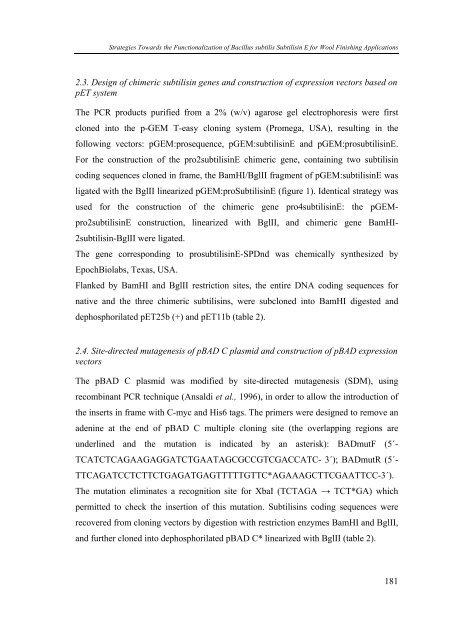Surface Modification of Cellulose Acetate with Cutinase and ...
Surface Modification of Cellulose Acetate with Cutinase and ...
Surface Modification of Cellulose Acetate with Cutinase and ...
You also want an ePaper? Increase the reach of your titles
YUMPU automatically turns print PDFs into web optimized ePapers that Google loves.
Strategies Towards the Functionalization <strong>of</strong> Bacillus subtilis Subtilisin E for Wool Finishing Applications<br />
2.3. Design <strong>of</strong> chimeric subtilisin genes <strong>and</strong> construction <strong>of</strong> expression vectors based on<br />
pET system<br />
The PCR products purified from a 2% (w/v) agarose gel electrophoresis were first<br />
cloned into the p-GEM T-easy cloning system (Promega, USA), resulting in the<br />
following vectors: pGEM:prosequence, pGEM:subtilisinE <strong>and</strong> pGEM:prosubtilisinE.<br />
For the construction <strong>of</strong> the pro2subtilisinE chimeric gene, containing two subtilisin<br />
coding sequences cloned in frame, the BamHI/BglII fragment <strong>of</strong> pGEM:subtilisinE was<br />
ligated <strong>with</strong> the BglII linearized pGEM:proSubtilisinE (figure 1). Identical strategy was<br />
used for the construction <strong>of</strong> the chimeric gene pro4subtilisinE: the pGEMpro2subtilisinE<br />
construction, linearized <strong>with</strong> BglII, <strong>and</strong> chimeric gene BamHI-<br />
2subtilisin-BglII were ligated.<br />
The gene corresponding to prosubtilisinE-SPDnd was chemically synthesized by<br />
EpochBiolabs, Texas, USA.<br />
Flanked by BamHI <strong>and</strong> BglII restriction sites, the entire DNA coding sequences for<br />
native <strong>and</strong> the three chimeric subtilisins, were subcloned into BamHI digested <strong>and</strong><br />
dephosphorilated pET25b (+) <strong>and</strong> pET11b (table 2).<br />
2.4. Site-directed mutagenesis <strong>of</strong> pBAD C plasmid <strong>and</strong> construction <strong>of</strong> pBAD expression<br />
vectors<br />
The pBAD C plasmid was modified by site-directed mutagenesis (SDM), using<br />
recombinant PCR technique (Ansaldi et al., 1996), in order to allow the introduction <strong>of</strong><br />
the inserts in frame <strong>with</strong> C-myc <strong>and</strong> His6 tags. The primers were designed to remove an<br />
adenine at the end <strong>of</strong> pBAD C multiple cloning site (the overlapping regions are<br />
underlined <strong>and</strong> the mutation is indicated by an asterisk): BADmutF (5´-<br />
TCATCTCAGAAGAGGATCTGAATAGCGCCGTCGACCATC- 3´); BADmutR (5´-<br />
TTCAGATCCTCTTCTGAGATGAGTTTTTGTTC*AGAAAGCTTCGAATTCC-3´).<br />
The mutation eliminates a recognition site for XbaI (TCTAGA → TCT*GA) which<br />
permitted to check the insertion <strong>of</strong> this mutation. Subtilisins coding sequences were<br />
recovered from cloning vectors by digestion <strong>with</strong> restriction enzymes BamHI <strong>and</strong> BglII,<br />
<strong>and</strong> further cloned into dephosphorilated pBAD C* linearized <strong>with</strong> BglII (table 2).<br />
181

















